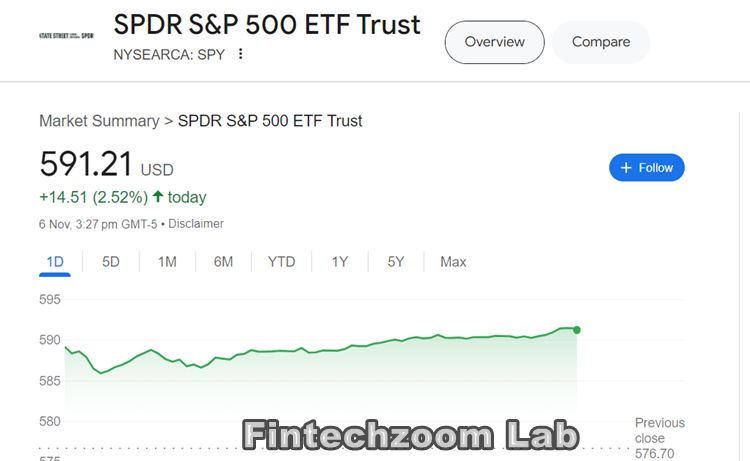In a world where economic indicators shift rapidly and the stock market evolves almost daily, keeping up with key market players is essential for both novice and experienced investors. Fintechzoom SPY Stock, representing the SPDR S&P 500 ETF Trust, serves as a comprehensive reflection of the U.S. equity market by tracking the S&P 500 index.
As one of the most closely watched ETFs, SPY is highly regarded for its ability to mirror the performance of the broader market, providing investors with instant access to a diversified range of sectors, from technology and healthcare to finance and consumer goods.
This guide provides a comprehensive look at recent developments surrounding SPY, dives into current trends, and explores the essential stock performance metrics to help investors make well-informed decisions.
What is SPY and Why Is It Significant?
SPY, an abbreviation for the SPDR SP 500 ETF Trust, was introduced in 1993 as the first exchange-traded fund (ETF) in the United States. Managed by State Street Global Advisors, it’s one of the largest ETFs globally, providing significant liquidity and low expense ratios.
The main draw of SPY stock lies in its ability to offer instant diversification across major sectors, such as technology, healthcare, finance, and consumer goods, all encapsulated within the S&P 500 index. This diversity mitigates single-stock risk, giving investors a broad market exposure without the complexity of individual stock selection.
How SPY Reflects Economic Health
As a mirror of the S&P 500, SPY represents the health of the U.S. economy. When the economy grows and corporate profits rise, SPY stock tends to appreciate, reflecting this optimism in the market. Conversely, during economic downturns, Fintechzoom SPY Stock performance typically declines, signaling investor caution. SPY thus serves as a reliable barometer for U.S. stock market health, providing insights into broader economic trends.
Since the SPY ETF covers sectors like technology, financials, consumer goods, and energy, its performance embodies a balanced view of the nation’s economic landscape. Changes in Fintechzoom SPY stock price often foreshadow or respond to shifts in Federal Reserve policy, inflation rates, and global economic factors.
Current Performance of Fintechzoom SPY Stock
Recent Fintechzoom SPY Stock performance has captured attention due to significant fluctuations, largely fueled by broader macroeconomic factors. Events such as Federal Reserve interest rate changes, inflationary pressures, and geopolitical tensions have all contributed to these market dynamics.
As SPY stock follows the S&P 500 index, any factor impacting the index will also influence SPY ETF stock.

Key Factors Influencing SPY
- Federal Reserve Policies: Changes in interest rates directly affect corporate borrowing costs, impacting earnings and, by extension, SPY.
- Corporate Earnings Trends: Quarterly earnings reports for large-cap companies in the S&P 500 play a crucial role in SPY’s movement.
- International Trade and Geopolitical Stability: Economic policies, tariffs, and geopolitical tensions can influence SPY stock trends.
Given these influential factors, monitoring historical SPY performance offers a basis for understanding its future potential, even if past trends don’t guarantee similar future outcomes.
Historical SPY Stock Performance and What It Means for Investors
Looking at historical SPY stock data, investors can gain perspective on how this ETF has weathered different economic cycles. From the dot-com boom to the 2008 financial crisis and the more recent pandemic-related downturn, SPY has reflected the ups and downs of the S&P 500. Studying these patterns helps investors establish realistic expectations and assess long-term stock growth.
However, it’s worth noting that SPY’s past performance may not indicate its future. External forces, evolving financial markets, and macroeconomic shifts can drive unexpected changes. Still, for those invested in long-term SPY stock performance, a historical perspective can underscore its resilience and potential for growth.
What Influences Fintechzoom SPY Stock Volatility?
Volatility in SPY stock often reflects the market’s response to larger economic shifts. Three primary factors contribute to SPY’s performance fluctuations:
- Interest Rate Adjustments: When the Federal Reserve raises or lowers interest rates, the cost of borrowing changes for S&P 500 companies, directly impacting SPY.
- Corporate Earnings Reports: Reports from sectors like technology, healthcare, and consumer goods can create ripple effects, as these industries have considerable weight in SPY.
- Global Events and Geopolitical Tensions: External pressures, such as international conflicts or trade wars, influence SPY ETF stock by affecting companies reliant on stable geopolitical conditions.
Monitoring these factors provides insight into SPY’s market volatility. By understanding what drives these changes, investors can make better decisions in response to economic developments.
SPY as a Benchmark: What Investors Should Know
Institutional investors frequently use SPY as a benchmark, measuring their portfolios’ performance against its returns. Even for retail investors, SPY is a useful indicator of broad market trends. If an individual stock underperforms relative to SPY, it might signal sector-specific challenges or potential growth opportunities elsewhere.
Pros and Cons of Investing in SPY ETF
SPY offers several advantages as an investment vehicle, but it also comes with potential drawbacks.
Pros of Investing in SPY Stock
- Broad Diversification: Investors gain exposure to all sectors within the S&P 500, minimizing single-stock risk.
- Liquidity: With its high trading volume, SPY is easily bought or sold, making it a flexible investment.
- Low Expense Ratios: SPY has lower fees compared to actively managed funds, reducing cost burdens on investors.
Cons of Investing in SPY Stock
- Market-Wide Exposure: During market downturns, SPY’s performance will mirror that of the broader market, making it susceptible to declines.
- Lack of Customization: SPY tracks the S&P 500 in its entirety, limiting investors’ ability to focus on particular sectors or growth stocks.
- Dependence on Economic Health: SPY’s value is tied to the U.S. economy, so it reflects market swings that may not align with every investor’s risk tolerance.
SPY Stock as Part of a Diversified Portfolio
While SPY ETF stock provides substantial market exposure, it’s best viewed as one part of a diversified portfolio. Combining SPY with assets like bonds, international stocks, or sector-specific funds helps mitigate risks. This diversification balances an investor’s portfolio, allowing it to withstand various economic conditions.
For instance, during a tech boom, SPY might perform well; however, bonds or international investments may offer stability when U.S. stocks face volatility.
Fintechzoom SPY Stock: Tips for New Investors
For investors new to the stock market, SPY serves as an approachable option. However, it’s essential to recognize that SPY stock investments involve inherent risks, particularly given SPY’s reflection of market-wide performance.
New investors should evaluate factors like market timing, relevant economic indicators, and their financial goals. Before diving in, understanding SPY’s performance patterns can lead to more strategic, informed decisions.
Latest Insights on SPY from Fintechzoom
Fintechzoom’s SPY stock insights highlight that certain sectors within SPY may outperform others in the near term. For instance, technology continues to adapt to evolving market needs, maintaining a strong presence in the SPY portfolio. In contrast, industries affected by international trade tensions or energy costs may encounter challenges.
Fintechzoom SPY stock analysis also points out that corporate earnings growth across key sectors could sustain positive momentum if economic conditions stabilize.
Frequently Asked Questions (FAQs)
What is the main appeal of investing in SPY ETF?
The primary attraction of SPY lies in its diversification and simplicity. By holding SPY, investors can essentially buy a slice of the entire S&P 500, gaining exposure to major companies in one investment.
How does SPY compare to other ETFs?
SPY stands out due to its liquidity and strong alignment with the S&P 500 index. Other ETFs may focus on smaller sectors or specific themes, but SPY offers a broad market approach, making it appealing for passive investors.
Is SPY suitable for long-term investment?
For those aiming to track the S&P 500 over time, SPY can serve as a valuable long-term growth tool. However, investors should be aware of market fluctuations and the potential for downturns in economic conditions.
What are the primary risks associated with SPY?
Since SPY mirrors the S&P 500, it’s vulnerable to market-wide declines. Economic downturns or significant events impacting U.S. companies will likely affect SPY’s performance.
How do Federal Reserve policies impact SPY stock?
Changes in interest rates set by the Federal Reserve can influence borrowing costs for companies in the S&P 500. If borrowing becomes more expensive, corporate growth may slow, which can negatively impact SPY stock performance.
Conclusion
In sum, SPY stock remains a powerful tool for investors who seek to tap into the broader U.S. market. Offering simplicity, diversity, and liquidity, SPY provides a solid foundation for both new and seasoned investors. Nevertheless, given SPY’s exposure to the S&P 500, it’s crucial for investors to stay informed about market trends, economic policies, and corporate earnings reports.
As with any investment, diversifying and understanding the factors influencing SPY ETF stock can help reduce risk and improve overall portfolio performance.
